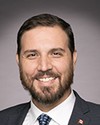About two-thirds of water body 3 is on the mine site and is part of the approved mining plan under the joint review panel as a settling pond and a containment pond, so it is integral to the long-term mining strategy.
I would note that the sampling of naphthenic acids and F2 hydrocarbons were, until recently.... We had one F2 hydrocarbon sample that exceeded the levels that are approved. Prior to that, all were at minimum levels or below exceedances. We have had no test results that suggest that any of those compounds have left water body 3.
As a result of seeing the first exceedance, we instructed Imperial to implement what we would call their next phase of containment around that water body. They're drilling a number of interception wells to intercept any potential seepage. They are putting in facilities across the water body to slow the movement of water across it and they've also begun construction on a containment facility, a dam, so that the outflow could be stopped if needed.



